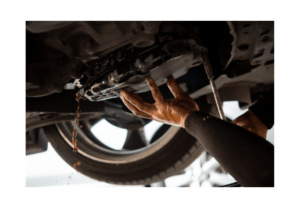An automatic transmission flush is a maintenance procedure that involves completely replacing the old transmission fluid with new fluid. This is done by flushing the old fluid out of the system and replacing it with new fluid. The process is typically performed using a special machine that is designed to flush out the old fluid and replace it with new fluid.
An automatic transmission flush is important because, over time the transmission fluid can become contaminated with debris, dirt, and other particles. This can cause the transmission to malfunction, which can result in costly repairs. By flushing the old fluid out of the system and replacing it with new fluid, you can help to ensure that your transmission is functioning properly and reduce the risk of damage.
This article will provide a comprehensive guide to automatic transmission flushes, including the benefits of the procedure, when it should be performed, and how to perform an automatic transmission flush. We will also discuss the potential risks associated with automatic transmission flushes and provide tips on how to avoid these risks. Finally, we will provide a step-by-step guide to performing an automatic transmission flush, including the tools and materials you will need, and the steps you should follow to ensure a successful flush.
Contents
Signs That Your Transmission Needs to be Flushed

Delayed Engagement
Delayed engagement when shifting gears: If you notice a delay in shifting gears when driving your vehicle, this could be a sign that your automatic transmission needs to be flushed. This could be caused by a buildup of debris and dirt in the transmission fluid, which prevents the fluid from flowing properly.
Transmission Slipping
Transmission slipping: If your vehicle’s transmission is slipping, it could be a sign that your automatic transmission needs to be flushed. This could be caused by a buildup of debris and dirt in the transmission fluid, which can cause the clutches to slip and fail to engage properly.
Noises and Vibrations
Unusual noises or vibrations: If you hear unusual noises or feel vibrations when driving your vehicle, this could be a sign that your automatic transmission needs to be flushed. This could be caused by a buildup of debris and dirt in the transmission fluid, which can cause the gears and bearings to wear down and become damaged.
Other Symptoms
Other symptoms that indicate the need for an automatic transmission flush: Other symptoms that could indicate the need for an automatic transmission flush include a burning smell coming from your vehicle, difficulty shifting gears, and a transmission that overheats. If you notice any of these symptoms, it’s important to have your transmission inspected and serviced by a qualified professional as soon as possible.
The Automatic Transmission Flush Process
1. To prepare the vehicle for an automatic transmission flush, the technician will typically perform a visual inspection of the transmission and check the transmission fluid level and condition. The technician may also test drive the vehicle to assess the performance of the transmission and identify any specific issues that need to be addressed before the flush.
2. The equipment used for an automatic transmission flush typically includes a transmission flush machine, which is designed to pump new transmission fluid through the transmission while simultaneously removing the old fluid. The machine is typically connected to the transmission cooler lines, which allows it to circulate fluid through the entire system. The technician may also use specialized tools to remove and replace the transmission pan, filter, and gasket as needed.
3. The actual flushing process involves running the engine and circulating the new fluid through the transmission while simultaneously removing the old fluid. The technician may also use a special cleaner to remove any buildup or debris in the transmission. The process may take anywhere from 30 minutes to a few hours, depending on the specific vehicle and the condition of the transmission.
4. Proper disposal of the old transmission fluid is essential for both environmental and safety reasons. The old fluid should be collected and disposed of according to local regulations. Many automotive shops have arrangements with local recycling centers or waste disposal companies to ensure proper disposal of used fluids.
Benefits of an Automatic Transmission Flush
An automatic transmission flush helps improve the performance of the transmission. Over time, transmission fluid can become contaminated with debris and metal particles, which can cause the transmission to work less efficiently. By flushing out the old fluid and replacing it with fresh, clean fluid, the transmission is able to operate more smoothly and effectively.
An automatic transmission flush can also help increase the longevity of the transmission. By removing any contaminants and debris that may be present in the old fluid, the new fluid can better lubricate and protect the moving parts of the transmission. This can help reduce wear and tear on the transmission and extend its overall lifespan.
One of the main benefits of an automatic transmission flush is that it can help prevent potential transmission problems. Flushing the transmission can remove any harmful debris or contaminants that may be present in the old fluid, which can help prevent clogs, leaks, and other issues that can lead to transmission failure.
In addition to the above benefits, an automatic transmission flush can also help improve fuel efficiency, reduce emissions, and provide a smoother, more comfortable ride. By keeping the transmission in good working condition, the vehicle is able to operate more efficiently and effectively, which can save money on fuel costs and reduce the environmental impact of the vehicle.
Potential Risks of Automatic Transmission Flush
One potential risk of an automatic transmission flush is the possibility of damage to the transmission. If the flushing process is not done correctly, it can dislodge debris and particles that could cause harm to the transmission components. This risk can be mitigated by ensuring that the flushing is done by a professional using proper equipment and procedures.
Another risk is the use of the wrong equipment or transmission fluid. Using the wrong type of fluid or equipment can cause damage to the transmission, which can lead to costly repairs. It is important to ensure that the correct type of fluid is used and that the equipment is suitable for the make and model of the vehicle.
DIY automatic transmission flush can also pose a risk if the person performing the flush is not familiar with the process or lacks the necessary expertise. This can result in damage to the transmission, as well as incorrect disposal of the old fluid, which can harm the environment.
Finally, it is important to emphasize the importance of professional automatic transmission flush services. Using a reputable and experienced professional can help to ensure that the process is done correctly and safely, reducing the risks of potential damage to the transmission.
Conclusion
An automatic transmission flush is an essential process to keep your vehicle’s transmission in top condition. The flushing process involves removing old transmission fluid and replacing it with new fluid, which helps to improve the performance and longevity of the transmission. In this article, we’ll discuss the signs that indicate the need for an automatic transmission flush, the process of flushing the transmission, the benefits, and potential risks associated with this process.
If you notice any delayed engagement when shifting gears, transmission slipping, or unusual noises or vibrations, it may indicate the need for an automatic transmission flush. Other symptoms include transmission overheating, the presence of debris in the fluid, or a burnt smell. These issues can be caused by old or contaminated transmission fluid, which can affect the performance of your vehicle’s transmission.
The automatic transmission flush process involves preparing the vehicle, using specialized equipment, and flushing out the old fluid before adding new fluid. The benefits of an automatic transmission flush include improved transmission performance, increased longevity of the transmission, and the prevention of potential transmission problems. However, there are also potential risks associated with this process, such as damage to the transmission, the use of the wrong equipment or transmission fluid, and the risks associated with a DIY automatic transmission flush.
An automatic transmission flush is an important process that can help maintain the health of your vehicle’s transmission. Regular maintenance of your vehicle’s transmission, including an automatic transmission flush, can prevent costly repairs and ensure a longer lifespan for your vehicle. It is important to follow proper procedures and seek professional services to ensure the process is done correctly and minimize any potential risks.

2 thoughts on “Automatic Transmission Flush – Key Benefits Listed”
Comments are closed.